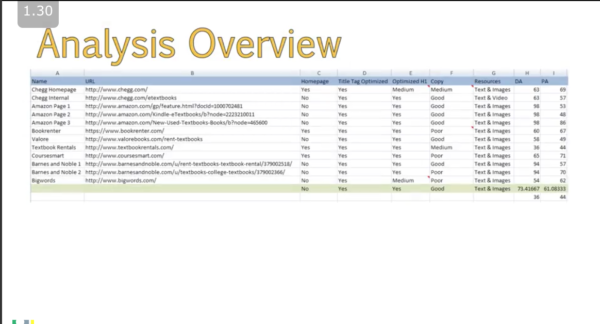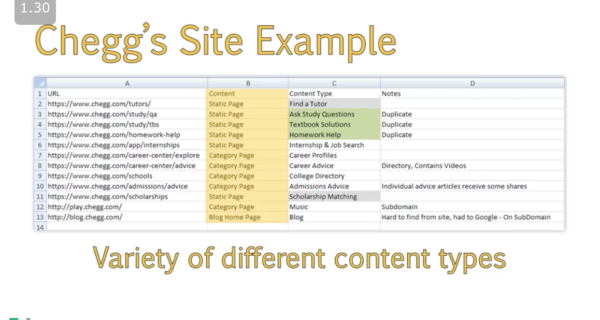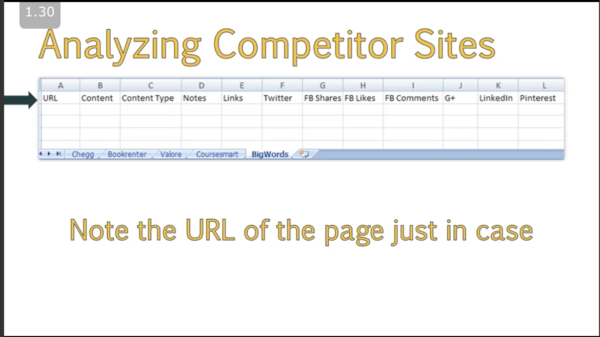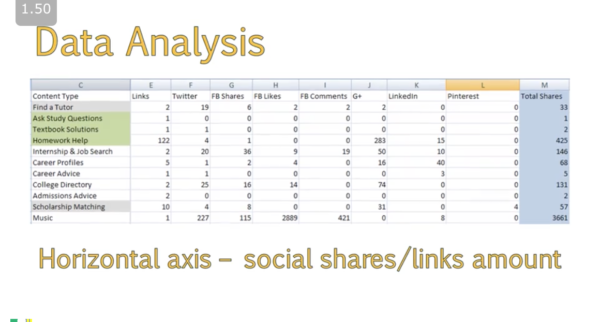Course 3: Optimizing a Website for Search
Week 1 – Applying Keyword Research
Keyword Competitive Analysis
- Select potential keywords we want to use
- Based on relevance, intent, and competitiveness
- Identify competition
- Evaluate competition and see where they are doing well.
- Analyze own site
Keyword selection
- Create an excel sheet with two columns
- Keyword and Avg. monthly searches (exact match only)
- List all the keywords and phrases that you think would be good keyword terms.
- Then order the list by highest to lowest monthly keyword search
- Plural and non-plural not necessary to optimize for
- You can use Google Analytics if a site is properly connected to analytics
- You can see competitor data to see what keywords are doing well for them.
- Majority of your site traffic will be long-tailed words
How to perform a Competitive Keyword Analysis
- Open a new excel tab from your keyword page
- Make tabs for main keyword themes
- use Moz keyword difficulty tool to see what sites are ranking the best for the keywords you’ve chosen to analyze (This is a paid subscription)
- User SERP analysis from MOZ to see who is ranking highest.
- You can do the same thing with Google but it’s not as user-friendly
How to see who your top competitors are for the keywords you’ve chosen.
- Google’s semantic system usually creates relationships with words that are synonymous like Ebook and electronic book.
- When that happens you can decide if you want to target both words.
- When you do your competitive analysis to see which sites are ranking best, sometimes a site that doesn’t focus on what you do will rank high because they’ve written a blog about the subject your website is about. In that case, they aren’t considered a “direct” competitor but they are an organic competitor.
- These non “direct” pages should still be focused on to outrank because these sites can draw away traffic that could have been driven to your site.
- Take note of the sites that are getting the most traffic. These are your main competitors
- Based on competitor analysis you can see how plausible it is to out rank them.
- Even major websites can be beaten with the right SEO strategy.
- It’s not easy to outrank major sites, but with a good budget to create good content and outreach
Competing with Page Level Information
- You can examine your top competitor’s website to see what they are doing well and what you can do for your own site.
- Create a new excel file for the competitors you uncovered.

- Creating pages with content specific to topics have a better chance of ranking
- Optimizing Title Tag’s is a simple low hanging fruit to optimize and outrank sites.
- DA = Domain Authority
- PA = Page Authority
- Use the average Domain authority and Page Authority to see how much you’ll need to do to get your website to start ranking on the first page of Google.
Summary
- Search volume for phrases, similar and variations of phrases
- User intent is focused on taking action
- To outrank competition focus on developing really great content, site authority, link building and research
- Provide variety of resources instead of just text and images.
Mapping Keywords to Pages
- Keyword map – A document that outlines the keywords for your site

- When you’re creating your site or optimizing your existing site, each page should have a focus on different keywords so you don’t cannibilize you’re own keyword traffic.

- Create an excel keyword map so that it’s easier to update later on.
- Keyword volume is an important metric to use when determining the keywords you plan to use. Too much search volume and it’s hard to rank well. Too little volume and you’ll get no traffic at all. Finding a good balance in between is key.
Week 2 – Advanced On-Page SEO
- Do an analysis of a competitors site
- Things to looks at
- URL
- Content (Static page, video)
- Content type (
- Notes
- Links to the pages (Moz open site explorer)
- Social media
- FB Shares, FB Likes


Content that will resonate with Customers?
- By analyzing your competitor’s site, you can see what content is resonating with your audience through social signals. (Google+, Facebook, Twitter, Link
- You can use ShareMetric which is a free Chrome extension

- You can see that there are a lot of shares on FB and Google+. This gives you an indication that your audience are sharers and you can put a specific call to action to get them to share your content.
- Linkedin is the most popular for career posts.
- Each social media site has its own focus. Be mindful of that. Linkedin career related. Facebook is more social in nature.
- Don’ copy your competitors content strategy but you can get an idea of what they are doing so you can create your own strategy.

Internal Content Audit
- If you have a lot of content, start an internal audit of your content.
- Supporting image on sites?
- Internal resource links?
- External resources links on page?
- Video?
- Can content be merged with another blog if they are similar?
- If blogs are extremely long should they be created into a multi-part series or guide?
How to Begin Content Analysis
- Start with pages that are already receiving organic visits
- Use Google Analytics to find current organic landing pages
- Look at last 6 months of data
- Filter for blogs so that you can analyze your blog content all at once instead of looking at all the pages on your site
Week 3 – Local SEO
Week 4 – Creating an SEO Campaign